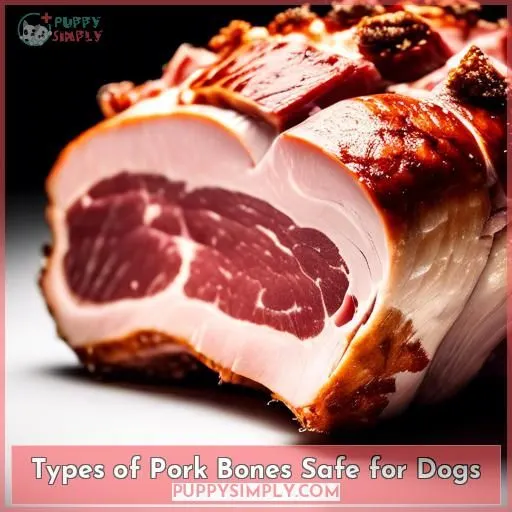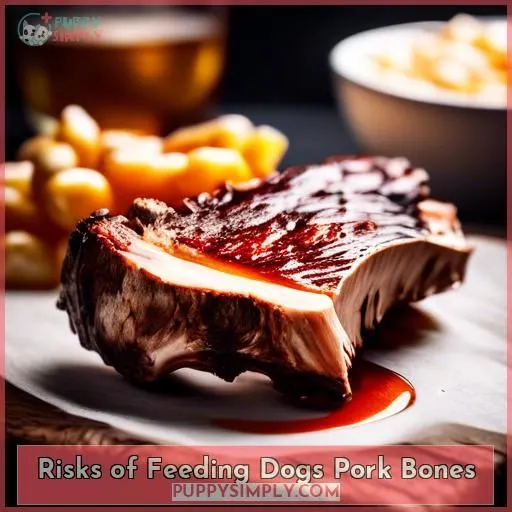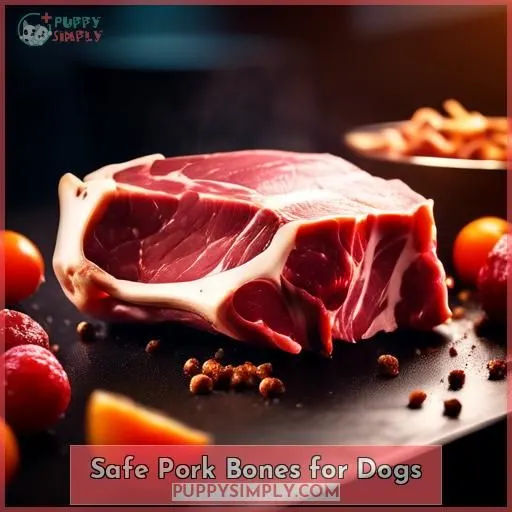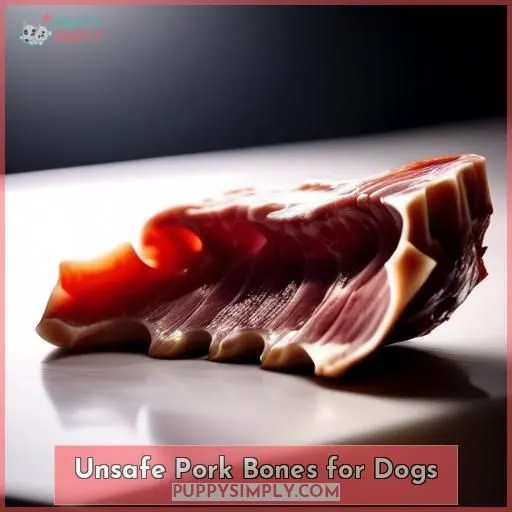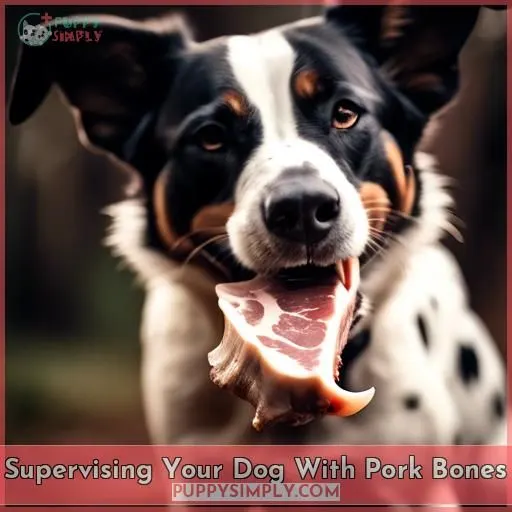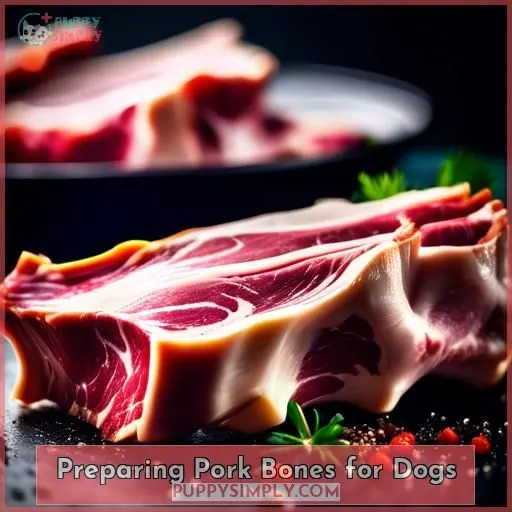This site is supported by our readers. We may earn a commission, at no cost to you, if you purchase through links.

You’re cautious about letting your pup gnaw on pork bones, specifically the boston butt bone.
Understandably so – certain bones splinter easily, causing obstructions or punctures.
This guide clarifies if dogs can safely consume boston butt bones by examining pork bone types and preparation methods that minimize risks.
Discover tailored tips to satisfy your dog’s chewing instincts without compromising their wellbeing.
Table Of Contents
- Key Takeaways
- Can Dogs Eat Boston Butt Bone?
- Can Dogs Eat Pork Bones?
- Types of Pork Bones Safe for Dogs
- Risks of Feeding Dogs Pork Bones
- Safe Pork Bones for Dogs
- Unsafe Pork Bones for Dogs
- Supervising Your Dog With Pork Bones
- Alternative Treats for Dogs
- Bone Alternatives for Large Breeds
- Bone Alternatives for Small Breeds
- Preparing Pork Bones for Dogs
- Frequently Asked Questions (FAQs)
- Conclusion
Key Takeaways
- Pork bones can pose risks such as bone splinters that can puncture the digestive tract and intestinal blockages that can lead to serious health issues.
- Raw meaty bones, like necks, tails, and feet, provide a wealth of nutrients and help keep your dog’s teeth clean. Recreational bones, such as flat bones from the spine, ribs, pelvis, and shoulders, provide mental stimulation and exercise for your dog’s neck and spine muscles.
- When giving your dog pork bones, it’s essential to supervise them closely, watch for small pieces breaking off or splintering, and remove the bone when it becomes small enough to be a choking hazard.
- Raw bones are less likely to splinter, but they come with other risks, such as bacteria associated with raw meat.
Can Dogs Eat Boston Butt Bone?
No, dogs should not eat Boston butt bones. Pork bones, whether raw or cooked, can splinter and crack when a dog chews on them, posing a choking hazard and risk of intestinal blockages or damage to the esophagus or intestines.
Can Dogs Eat Pork Bones?
Dogs can eat pork bones, but it’s crucial to be aware of the risks involved. Pork rib bones can splinter into shards, which can cause choking, damage to the mouth, throat, and intestines, and block the intestines. Cooked pork bones are more likely to splinter, while raw bones are more likely to be coated with bacteria. Consuming pork rib bones can also lead to pancreatitis, a life-threatening illness associated with consuming high-fat meals.
However, there are safer options for dogs. Raw meaty bones, such as necks, tails, and feet, are safer for dogs. Recreational bones, like flat bones from the spine, ribs, pelvis, and shoulder, can also be given to dogs. It’s essential to choose bones from young, organically raised grass-fed animals and avoid bones with sharp edges or small pieces, cooked bones, weight-bearing bones, old bones, or bones from older animals.
When giving your dog pork bones, it’s essential to supervise them closely, watch for small pieces breaking off or splintering, and remove the bone when it becomes small enough to be a choking hazard. Raw bones are less likely to splinter, but they come with other risks, such as bacteria associated with raw meat.
Types of Pork Bones Safe for Dogs
Raw meaty bones, like necks and tails, provide a wealth of nutrients and help keep your dog’s teeth clean. Recreational bones, such as flat bones from the spine, ribs, pelvis, and shoulder, provide mental stimulation and exercise for your dog’s neck and spine muscles.
Raw Meaty Bones
Raw meaty bones, such as necks, tails, and feet, offer numerous benefits for your dog.
They’re a natural source of minerals like magnesium, phosphorus, and calcium, as well as fat and protein.
However, consuming raw meaty bones requires careful consideration.
Avoid sharp edges or small pieces, and supervise your dog to ensure safety.
Raw marrow bones are safe, but other bones, like pork chop bones, can be dangerous.
Always choose bones that are large, rounded, and free from splinters.
Recreational Bones
Recreational bones are a type of pork bone that can be safe for dogs.
These bones are often larger and rounded, such as flat bones from the spine, ribs, pelvis, and shoulder.
They’re designed to enhance bone density and provide a source of bone marrow.
However, it’s crucial to consider bone size and source, as well as how you handle the bones, to ensure safety.
Always supervise your dog while they chew on these bones to avoid potential risks.
Choosing Pork Bones for Dogs
After diving into the world of recreational bones, let’s zero in on picking the right pork bones for your furry friend.
Opt for bones from pastured pigs, rich in omega fatty acids, ensuring a healthy fat balance.
Size matters; avoid rib and ham bones that can splinter.
Choose wisely, and let your pup gnaw away safely!
Risks of Feeding Dogs Pork Bones
When given to dogs, pork bones can pose risks such as bone splinters that can puncture the digestive tract, and intestinal blockages that can lead to serious health issues. It’s important to be aware of these risks and take precautions to ensure your dog’s safety.
Bone Splinters
When it comes to pork bones, it’s essential to be cautious. Cooked pork bones can splinter into sharp shards, posing a choking hazard and risk of damage to your dog’s mouth, throat, and intestines. Even raw pork bones can be dangerous, as they can break into small pieces and cause intestinal blockages or lacerations.
Bone splinters can lead to severe issues, such as bleeding, bowel perforation, and even death. Fish bones, for example, can be particularly hazardous due to their sharp and brittle nature. Therefore, it’s crucial to avoid feeding your dog pork bones, especially cooked ones, to prevent these risks.
Instead, consider safer alternatives for your dog’s chewing needs. Bully sticks, antlers, and tough rubber toys are recommended as safer options. Always supervise your dog when they’re chewing to ensure their safety.
Intestinal Blockages
Intestinal blockages are a potential risk when feeding dogs pork bones. These can occur due to the ingestion of small, sharp pieces that can get lodged in the intestines, causing a blockage.
To minimize this risk, it’s essential to supervise your dog when chewing on bones.
Additionally, consider freezing bones to reduce the risk of parasites like trichinosis, roundworms, and hookworms.
It’s also advisable to choose bones from pastured pigs and avoid factory-farmed pork bones.
Esophagus Damage
Feeding your dog a Boston butt bone can lead to esophageal perforation, bleeding, obstruction, irritation, and injury. These risks are particularly high for bones with sharp edges or small pieces, cooked bones, weight-bearing bones, old bones, or bones from older animals.
To minimize these risks, choose bones from pastured pigs, avoid factory-farmed pork bones, and supervise your dog while chewing.
Safe Pork Bones for Dogs
Raw meaty bones, recreational bones, and bones from pastured pigs are safe pork bones for dogs. Choose bones that are large and rounded, and supervise your dog while they’re chewing to prevent any accidents.
Raw Bones
Raw bones are a popular choice for dog owners seeking to provide their pets with a natural and beneficial chewing experience. They offer several benefits, such as improving oral health and providing a source of minerals like magnesium, phosphorus, and calcium.
- Avoid weight-bearing bones: These can splinter and cause harm to your dog.
- Choose bird bones: They’re softer and less likely to splinter.
- Supervise your dog: Always supervise your dog when they’re chewing on raw bones to ensure their safety.
Cooked Bones
While raw bones can be a chewy delight for your pup, cooked bones are a no-go zone.
They are notorious for splintering, turning a treat into a choking hazard faster than you can say drop it!
Moreover, the nutritional benefits go up in smoke with the cooking process.
Stick to safe cooking methods and avoid turning bones into risky business for your furry friend.
Bones From Pastured Pigs
Bones from pastured pigs offer numerous benefits for dogs, including a healthy source of minerals and improved oral health. However, there are potential health risks and parasite safety concerns. To ensure your dog’s safety, choose bones from young, organically raised animals.
Avoid weight-bearing bones, old bones, and bones from older animals. Always supervise your dog when chewing on pork bones.
Unsafe Pork Bones for Dogs
Unsafe pork bones include weight-bearing bones, old bones, and bones from older animals, as they can splinter and cause serious injuries or blockages.
Weight-Bearing Bones
Weight-bearing bones, like those from the femur, pose significant risks to your dog’s safety. These bones can splinter, causing damage or even bowel perforation. To ensure your dog’s safety, it’s crucial to supervise them when chewing on bones and consider alternative treats.
Old Bones
Old bones can be dangerous for dogs. Brittle bones splinter easily, posing a risk of injury. Parasites may accumulate in old bones, increasing the risk of infection. Freezing bones can reduce the risk of parasites and splintering.
Bones From Older Animals
When it comes to bones from older animals, it’s crucial to avoid them for your furry friend.
These bones can be brittle and splinter easily, posing a significant risk of injury. Additionally, older animals may have accumulated parasites, such as roundworms or hookworms, which can be transmitted through the bones.
Factory-farmed meats often carry a higher risk of these parasites. It’s advisable to choose bones from pastured pigs instead.
In the realm of dog health, safety is paramount. It’s not merely about providing a treat – it’s designed to enhance their well-being.
Supervising Your Dog With Pork Bones
When you let your furry friend chomp on a Boston butt bone, keeping a hawk’s eye on them is crucial.
- Parasite Prevention: Freezing the bone before giving it to your dog can help kill off any nasty critters, but you’ll still want to watch for any signs of discomfort or illness.
- Choking Hazard: Even the most enthusiastic chewers can bite off more than they can chew. Stay alert to prevent any scary choking incidents.
- Overconsumption Warning: Dogs sometimes don’t know when to stop. Ensure they’re not overindulging to avoid a bellyache—or worse.
- Supervision Importance: Your presence can deter them from turning that bone into a toothpick. Plus, you’ll get to see the dental benefits firsthand, as they work those jaw muscles and clean their teeth, all under your watchful eye.
Alternative Treats for Dogs
When it comes to treating your furry friend, you want to ensure you’re providing them with something that’s not only safe but also beneficial. While pork bones can be a tempting treat, they come with risks like bone splinters, intestinal blockages, and esophagus damage. So, what’re the alternatives?
Firstly, consider treats that help with teeth cleaning and tartar removal. Greenies, for instance, are a popular choice. They’re not only tasty but also designed to enhance dental health. Another option is rawhide, which can help reduce boredom and keep your dog occupied. However, be cautious with rawhide as it can pose a choking hazard if not given appropriately.
For those with allergies, look for hypoallergenic treats. These are specifically formulated to minimize the risk of adverse reactions. Lastly, remember that treats should be given in moderation, as part of a balanced diet. It’s not merely about satisfying their cravings; it’s about providing them with a balanced diet that supports their overall health.
Bone Alternatives for Large Breeds
If you’re looking for alternatives to pork bones for your large breed dog, there are several options to consider.
- Bone Marrow: This is a natural and nutritious treat for dogs. It’s rich in vitamins and minerals and can be a great source of calcium and phosphorus.
- Synthetic Bones: These are made from materials like rubber or plastic and come in various sizes and shapes. They’re designed to last longer than real bones and are less likely to splinter.
- Antler Chews: These are a popular choice for many dog owners. They’re natural, long-lasting, and contain essential minerals that can support your dog’s health.
- Dental Chews: These are specifically designed to help keep your dog’s teeth clean and healthy. They’re available in various sizes and flavors and can be a great way to keep your large breed pup entertained.
- Nylabones: These are a classic choice for many dog owners. They’re durable, long-lasting, and come in various sizes and shapes. They’re also designed to help keep your dog’s teeth clean and can be a great way to keep them busy.
Bone Alternatives for Small Breeds
As a responsible pet owner, you want to provide the best for your small breed dog. While bones can offer dental benefits, weight management, and digestive health, they can also pose risks.
- Puppy Treats: Opt for puppy treats specifically designed for small breeds. These treats are typically smaller in size and can provide the same benefits as bones without the potential risks.
- Dental Chews: Dental chews are a great alternative to bones. They help maintain dental health by removing tartar and preventing plaque buildup. Choose chews that are appropriate for your dog’s size and chewing ability.
- Rawhide Alternatives: Some dogs enjoy the texture of rawhide, but it can be a choking hazard. Look for rawhide alternatives made from natural ingredients like sweet potato or carrot. These treats are softer and easier to chew, reducing the risk of choking.
Preparing Pork Bones for Dogs
Start by trimming visible fat from the pork bone to reduce the risk of pancreatitis. Freeze the bone to kill any potential parasites and make it less likely to splinter.
Cooking Pork Bones
Cooking pork bones for your dog can be a great way to provide them with a nutritious and delicious treat. However, it’s essential to follow specific guidelines to ensure their safety and enjoyment.
- Choose high-quality pork neck bones: Look for bones that come from reputable sources, preferably organic and free-range. This ensures that the meat and bones are free from antibiotics, hormones, and any potential contaminants.
- Properly portion the bones: Depending on the size of your dog, you may need to cut the pork neck bones into smaller pieces. This allows for easier handling and reduces the risk of choking.
- Cook the bones thoroughly: To eliminate any harmful bacteria, it’s essential to cook the pork neck bones until they reach an internal temperature of 165°F (74°C). This ensures that they’re safe for consumption.
- Avoid seasonings: While it may be tempting to add flavors to the bones, it’s best to keep them plain. Seasonings like salt, garlic, and onion can be harmful to dogs.
- Supervise your dog while they enjoy their pork neck bones: Ensure they’re chewing them safely and not swallowing large pieces that could pose a choking hazard or cause intestinal blockages.
Freezing Pork Bones
Freezing pork bones is a crucial step in ensuring their safety and nutritional value for your dog.
- Parasite prevention: Freezing pork bones at a temperature of 5°F (-15°C) for 20 days can effectively kill any worms, including Trichinella, which can cause trichinellosis.
- Bone selection: Choose bones that are less than 6 inches thick for freezing, as this is the recommended thickness for killing worms.
- Safe storage: Wrap the bones in freezer paper, heavy-duty plastic bags, or heavy-duty aluminum foil to protect them from contamination and ensure they’re stored properly in the freezer.
- Nutritional value: Freezing pork bones can help preserve their nutritional value, as it can prevent the bones from becoming rancid or developing off-flavors.
Remember to always supervise your dog when chewing on frozen pork bones to prevent choking or other injuries.
Trimming Visible Fat
When preparing pork bones for your dog, it’s crucial to trim visible fat to ensure a healthy, enjoyable treat. This step not only enhances the nutritional content but also aids in parasite prevention and hygiene protocols.
By selecting bones with the right nutritional balance, you’re providing a safe and enjoyable recreational chewing experience for your furry friend.
Considering Omega Fatty Acids
When preparing pork bones for your dog, consider the omega fatty acid content. Pastured pigs have higher omega-3s, which can benefit your dog’s health. However, factory-farmed pork bones may pose a higher parasite risk. Freeze the bones to reduce this risk.
Avoiding Factory-Farmed Pork Bones
After diving into the omega fatty acids benefits, let’s chew on why you should steer clear of factory-farmed pork bones.
These bones often come from animals raised in inhumane conditions, increasing the parasite risk.
Opting for organic, grass-fed meats not only boosts those beneficial omega fatty acids but also slashes the chance of unwelcome critters.
It’s a win-win for your pup’s health and happiness.
Frequently Asked Questions (FAQs)
Can dogs eat pork butt bones?
Absolutely not! Pork butt bones can splinter, causing obstructions or perforations. They’re dense and may fracture teeth too. For safe chewing, give uncooked, rounded bones from safe sources instead.
What are the risks of feeding dogs pork bones?
Feeding pork bones risks tooth fractures, oral lacerations, intestinal perforations. Brittle, sharp edges splinter easily, causing obstructions, choking hazards. Raw meaty pork bones are safer options when monitored.
How should I prepare pork bones for my dog?
To properly prepare pork bones, freeze first to kill parasites. Remove any small shards or cooked portions, leaving only large, raw, meaty sections.
What are the benefits of feeding dogs pork bones?
Providing pork bones satisfies your dog’s primal cravings – gnawing exercises jaws, scraping tartar, and stimulating mental enrichment through natural chewing behaviors.
Can dogs eat cooked pork bones?
No, you shouldn’t feed your dog cooked pork bones. Cooked bones are brittle and can splinter, puncturing your pup’s digestive tract. Opt for raw, meaty pork bones instead – they’re safer and more digestible for Fido.
Conclusion
Over 60% of dogs that ingest bones experience no ill effects.
But caution is wise with the boston butt bone.
Feeding your pup appropriate raw, meaty pork bones minimizes splinter and blockage risks.
Monitor closely.
Offer alternatives like bully sticks or rubber chews for powerful chewers.
Consult your vet if concerned about your dog’s chewing habits.
With preparation and supervision, you can satisfy your canine’s urge to gnaw while keeping them safe.


